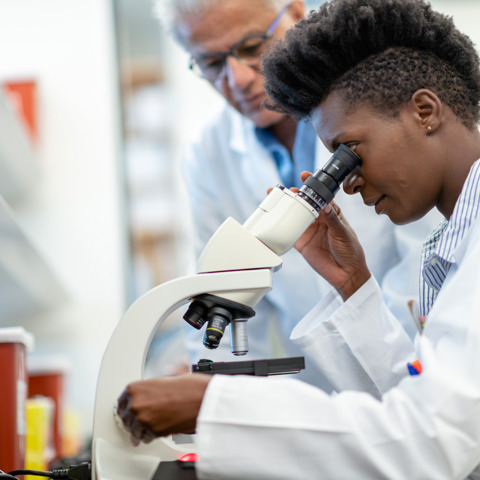
Searching for the follow-up after breakthrough in diabetes research - Blog report 4
DRWF Research Manager Dr Eleanor Kennedy files her final report from home on the final day of the 56th annual meeting of the European Association for the Study of Diabetes, this year presented as a virtual event.
I’m not even sure I know how this has happened, but it is already the last day of the virtual conference and, frankly, I’m as tired as I would have been had I been at the actual physical conference.
There has been so much science and research presented and, although I cannot see any of them, it turns out that more than 20,000 people have registered for this online edition of the European Association for the Study of Diabetes annual conference. This is up by around 25% on the normal figure and, interestingly, the countries that have the most delegates are those that normally would not attend in such numbers – Brazil is in gold medal position, with Germany and Mexico filling out the podium in silver and bronze position. Egypt, Saudi Arabia and Romania also feature in the top 10. To have reached out to such a truly global audience must be heartening of this Annual Meeting’s organisers.
What is on the menu for the final day?
I opt for a session I might not ordinarily have chosen – Implementation science in diabetes. The reason? Because I often get asked how research feeds into the care, treatment and management of patients with diabetes at the front line. When DRWF funds research, how do we know if any of it is going to make a real difference to people living with the condition? In truth, that is a very thorny issue. But its one that the EASD is looking to tackle.

So what did I learn?
Every year, all around the world, hundreds of billions of US dollars are pumped into biomedical and health research. However, one of the most consistent findings from clinical and healthcare services research is the failure to translate research into meaningful changes in either practice or policy, leading the first presenter of the sessions to say, “All breakthrough, no follow through!”
The gaps between research evidence and routine care are palpable: 30-40% of people do not receive care in accordance with current scientific evidence and a staggering 20-25% of the healthcare provided is not actually needed.
What is implantation science?
Well, this is loosely defined as “scientific study of methods to promote the systematic uptake of research findings and other evidence-based practices into routine practice”. For example, the science of the bridge between discovery and impact.
It seemed like a good idea
In a humorous interlude, three different research strategies were defined:
- The ‘Throw Everything at the Problem’ model – but many interventions or strategies at once is not necessarily better
- The ‘Use a Favourite Strategy’ model – but just because you have a hammer and everything looks like nail, this may not be fit for purpose and so you may need to expand the toolbox of solutions
- The ‘ISLAGIATT’ model – ‘it seemed like a good idea at the time’, which can often be an expensive version of trial and error

The message was very clear
We need to move beyond ‘ISLAGIATT’ in order to optimise diabetes care. It is inefficient in that it often does not build on what we already know. It is insufficient as it may miss important factors. And, importantly, it is unscientific as it is based on implicit ideas about what drives change into practice - and implicit ideas undermine scale, spread and evidence accumulation
Whilst this is undoubtedly true for many pieces of research, what about the research that really did come from an ‘ISLAGIATT’ idea? What about those giant leaps of faith that have taken us so far in our quest to offer better treatment modalities for people living with diabetes?
The STEP Programme is one such example – using a drug, semaglutide, that was developed for diabetes, researchers have now shown it to be effective in clinically meaningful weight loss.
The commentary that accompanied these trial results highlighted that, in both the UK and the USA, the most common new year’s resolution among adults is to lose weight. So could this research take us a long way to fulfilling many countries’ needs to reduce the number of people living with overweight and obesity? Today, we have some centrally acting agents but what about tomorrow and next week and next year? Thanks to research, we’re looking at a whole new era of dual and, maybe, triple therapies – combinations of drugs that can treat diabetes and, importantly, treat obesity, one of the major contributing factors to type 2 diabetes.
In all of this new research and discussion over what is next to hit our collective medicine cupboard, let’s not forget some of the ideas, maybe crazy at the time, that got us where we are now.
Metformin!
Metformin, the grand old lady of diabetes treatment and management, has been recommended as a monotherapy by all international guidelines for people newly diagnosed with type 2 diabetes. So, whilst there is much hoopla from many (myself included) around the cardiovascular protection offered by expensive new drugs like the SGLT-2 inhibitors, let’s not forget that metformin is a much cheaper drug. As highlighted in the EASD’s innovative new Around the Diabetes World in 80 Days online learning initiative, the cheaper drugs are the ones that are available globally and being used to treat literally millions of people in places where the whizzy new drugs are not available.
It is a sobering thought with which to end this year’s conference and I hope that by next year’s congress, be it actual or virtual, I’ll be able to report on a system less tied to wealth and aimed more at answering genuine and very obvious worldwide need.
Support DRWF by making a donation here
Find out more about DRWF-funded research here
Find out more about DRWF fundraising here
For latest update follow DRWF on Facebook, Instagram and Twitter
To receive the charity’s latest bulletins as they become available, please sign up here
Read DRWF diabetes information leaflets here
Join the Diabetes Wellness Network here
I would like to make a regular donation of
I would like to make a single donation of
There are lots of ways to raise money to support
people living with all forms of diabetes.
Bake, Swim, Cycle, Fly ... Do It For DRWF!
Fundraise with us
Recent News


